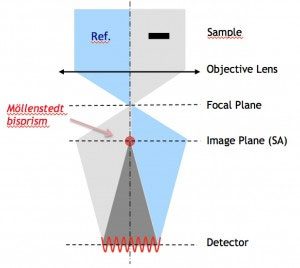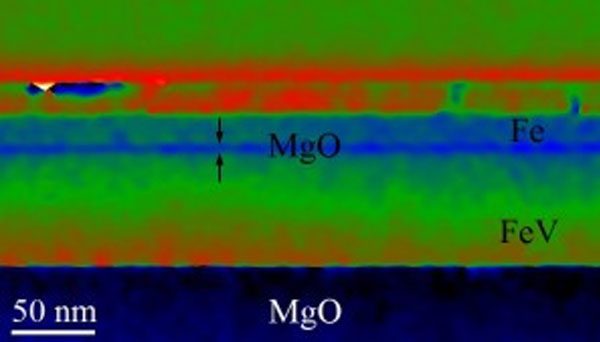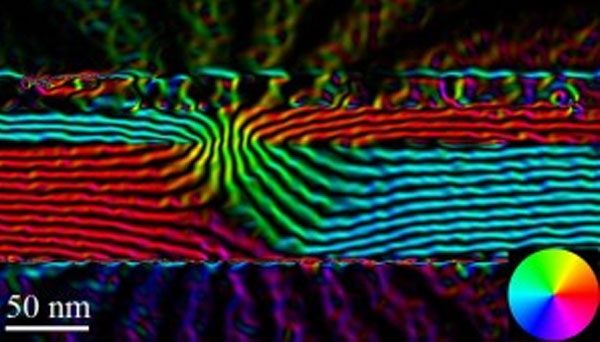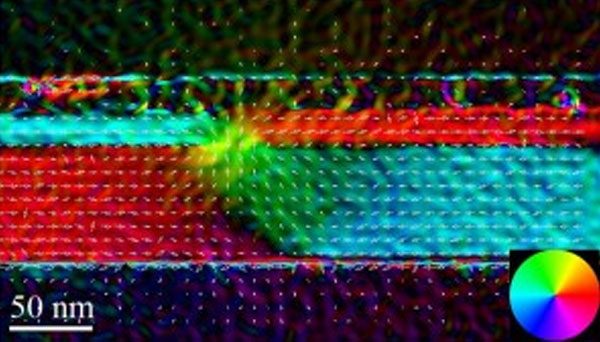Electron Holography form quantitative magnetic fields mapping
Off-axis Electron Holography (EH) is an interferometric technique that allows the measurement of the phase shift of the electron wave having interacted with static electrostatic and magnetic fields. This phase shift gives quantitative information about these electromagnetic fields.
In off-axis EH the phase shift measurement is performed by overlapping a so-called “reference” beam, which has not interacted with any field and just travelled through the vacuum, and a beam that has been phase shifted after interaction with any electromagnetic field inside the sample and with possible stray fields out of it. The overlapping of the two beams is realized thanks to an electrostatic biprism (Möllenstedt biprism) located in the SA image plane. This produces an interference pattern (a hologram) which can be analyzed quantitatively to determine the phase shift.

overlap creates an interference pattern (i.e. the hologram) between the two beams:

where ψref is the reference electron wave; ψs the electron wave that has been phase shifted, As the amplitude of ψs, φs(x,y) its phase shift after interaction with the sample and surrounding stray fields, RO the periodicity of the hologram fringes (which depend on the polarization of the biprism and the accelerating voltage).
The phase shift φs(x,y) is given by the Aharonov-Bohm effect:

where V(x,y,z) is the electrostatic potential, B(x,y,z) the component of the magnetic induction perpendicular to the beam ; CE a constant depending on the beam energy, and e and ℏ the electron charge and Planck constant, respectively.
The phase shift then contains two terms:
- The first term represents the electrostatic contribution to the phase shift of the wave.
- The second term carries the magnetic contribution to the phase shift (note that only the component of the magnetic induction perpendicular to the electron beam B⊥(x,y,z), contributes to the phase shift).
One of the major issues for the determination of magnetic properties by EH the separation of both magnetic and electrostatic contributions. This can be achieved by different methods one being to perform a first EH experiment, then turning upside down the sample and doing a second one. The phase shift due to the magnetic contribution is changed in sign, while the electrostatic part remains constant. Image calculations allow for separating both as in the forthcoming example.
EH study of a FeV/MgO/Fe magnetic tunnel junction:

Electrostatic contribution to the phase shift

Magnetic contribution to the phase shift

Contour lines (isophase) showing the magnetic flux spreading across a pinhole in the MgO barrier

Vectorial map of the same experiment indicating the distribution of the magnetic induction.
At the LMA-INA we develop experimental EH methods to perform these measurements with optimal spatial resolution (below 2 nm in the FEI Titan Cube) and phase sensitivity at various temperatures and under the controlled in-situ application of external magnetic field. EH is then developed for the quantitative study of magnetic configurations of magnetic nano-objects such as nanoparticles, nanowires, magnetic thin film, magnetic tunnel junctions (MTJs), magnetoresistive multilayers… These studies are performed in the remanent state but also performing in-situ experiments to describe the magnetic reversal process of the magnetic samples.
An example of such EH studies is reported in the figure below, which shows the magnetic reversal studies of a LCMO/STO/LSMO MTJ performed at 100 K:

Laboratorio de Microscopías Avanzadas
We are a unique initiative at national and international levels. We provide the scientific and industrial community with the most advanced infrastructures in Nanofabrication, Local Probe and Electron Microscopies for the observation, characterization, nanopatterning and handling of materials at atomic and molecular scale.
Contact information
Campus Río Ebro, Edificio Edificio I+D+i
Direct Links
© 2021 LMA | Website developed by o10media | Política de privacidad | Aviso legal | Condiciones de uso | Política de Cookies |







